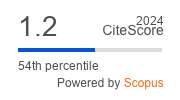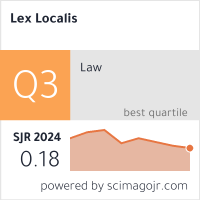Spatial Accessibility Models of the Efficient Network of Secondary Healthcare Providers in Slovenia
DOI:
https://doi.org/10.4335/21.4.751-774(2023)Keywords:
general hospital, accessibility, network, efficiency, location–allocation modelsAbstract
The main purpose of our research was to assess the accessibility of existing providers of secondary healthcare using established theoretical models of spatial accessibility. In the study, we analyzed the optimal locations and the optimal number of healthcare providers needed for an efficient network of secondary healthcare providers in Slovenia. We used four different location–allocation models and found that the MA-model is the most suitable for planning a potentially efficient network of general hospitals in Slovenia. We showed various scenarios for the development of the general hospital network based on three distinct accessibility travel time intervals, while also taking into account various population coverage proportions that can access hospital services within a given travel time interval. The key finding is that the same coverage of the population with hospital services could be achieved with a smaller number of general hospitals, if the hospitals were optimally located.
References
Algharib, S. M. (2011) Distance and coverage: An assessment of location-allocation models for fire stations in Kuwait city, Kuwait (doctoral dissertation) (Ohio: Kent State University).
Alhothali, A., Alwated, B., Faisal, K., Alshammari, S., Alotaibi, R., Alghanmi, N., Bamasag, O. & Bin Yamin, M. (2022) Location-Allocation Model to Improve the Distribution of COVID-19 Vaccine Centers in Jeddah City, Saudi Arabia, International Journal of Environmental Research and Public Health, 19(14), p. 8755, https://doi.org/10.3390/ijerph19148755.
Brabyn, L. & Skelly, C. (2002) Modeling population access in New Zealand public hospitals, International Journal of Health Geographics, 1(1), pp. 1–9, https://doi.org/10.1186/1476-072x-1-3.
Buzai, G. (2013) Location–allocation models applied to urban public services. Spatial analysis of Primary Health Care Centers in the city of Luján, Argentina, Hungarian Geographical Bulletin, 62(4), pp. 387–408.
Church, R. L. & Murray, A. (2009) Business site selection, location analysis and GIS (Hoboken: John Wiley & Sons).
Dai, D. (2010) Black residential segregation, disparities in spatial access to health care facilities, and late-stage breast cancer diagnosis in metropolitan Detroit, Health & Place, 16(5), pp. 1038-1052, https://doi.org/10.1016/j.healthplace.2010.06.012.
Daskin, M. (2008) What you should know about location modeling, Naval Research Logistics, 55(4), pp. 283–294, https://doi.org/10.1002/nav.20284.
Dos Anjos Luis, A. & Cabral, P. (2016) Geographic accessibility to primary healthcare centers in Mozambique, International Journal for Equity in Health, 15(1), pp. 173, https://doi.org/10.1186/s12939-016-0455-0.
Farinha, R., Oliveira, M. D. & de Sá, A. B. (2008) Networks of primary and secondary care services: how to organise services so as to promote efficiency and quality in access while reducing costs, Quality in Primary Care, 16(4), pp. 249–258.
Fortney, J. C., Burgess, J. F., Bosworth, H. B., Booth, B. M. & Kaboli, P. J. (2011) A re-conceptualization of access for 21st century healthcare, Journal of General Internal Medicine, 26(2), pp. 639–647, https://doi.org/10.1007/s11606-011-1806-6.
Guagliardo, M. F. (2004) Spatial accessibility of primary care: Concepts, methods and challenges, International Journal of Health Geographics, 3(1), pp. 3, https://doi.org/10.1186/1476-072X-3-3.
Hare, T. S. & Barcus, H. R. (2007) Geographical accessibility and Kentucky’s Heart-Related hospital services, Applied Geography, 27(3–4), pp. 181–205, https://doi.org/10.1016/j.apgeog.2007.07.004.
Heider, D., Matschinger, H., Müller, H., Saum, K. U., Quinzler, R., Haefeli, W. E., Wild, B., Lehnert, T., Brenner, H. & König, H. H. (2014) Health care costs in the elderly in Germany: An analysis applying Andersen’s behavioral model of health care utilization, BMC Health Services Research, 14 (7), pp. 1–12, https://doi.org/10.1186/1472-6963-14-71.
Holmes, J., Williams, F. & Brown, L. (2010) Facility location under maximum travel restriction: An example using day care facilities, Geographical Analysis, 4(3), pp. 258–266, https://doi.org/10.1111/j.1538-4632.1972.tb00474.x.
Huerta Munoz, U. & Källestål, C. (2012) Geographical accessibility and spatial coverage modeling of the primary health care network in the Western Province of Rwanda, International Journal of Health Geographics, 11(1), pp. 40, https://doi.org/10.1186/1476-072X-11-40.
Jankowski, P. (2014) Health care accessibility modeling: Effects of change in spatial representation of demand for primary health care services, Quaestiones Geographicae, 33(3), pp. 39–53, https://doi.org/10.2478/quageo-2013-0028.
Jin, M., Liu, L., Tong, D., Gong, Y. & Liu, Y. (2019) Evaluating the spatial accessibility and distribution balance of multi-level medical service facilities, International Journal of Environmental Research and Public Health, 16(7), pp. 1150, https://doi.org/10.3390/ijerph16071150.
Mason, D. & Menard, M. (2022) Accessibility of nonprofit services: Transportation network companies and client mobility, Nonprofit Policy Forum, 13(4), pp. 333–343, https://doi.org/10.1515/npf-2021-0059.
Messina, J. P., Shortridge, A. M., Groop, R. E., Varnakovida, P. & Finn, M. J. (2006) Evaluating Michigan’s community hospital access: Spatial methods for decision support, International Journal of Health Geographics, 5(1), pp. 1–18, https://doi.org/10.1186/1476-072X-5-42.
Murad, A., Faruque, F., Naji, A. & Tiwari, A. (2021) Using the location-allocation P-median model for optimising locations for health care centres in the city of Jeddah City, Saudi Arabia, Geospatial Health, 16(2), https://doi.org/10.4081/gh.2021.1002.
Murawski, L. & Church, R. L. (2009) Improving accessibility to rural health services: The maximal covering network improvement problem, Socio-Economic Planning Sciences, 43(2), pp. 102–110, https://doi.org/10.1016/j.seps.2008.02.012.
Oliver, A. & Mossialos, E. (2004) Equity of access to health care: Outlining the foundations for action, Journal of Epidemiology and Community Health, 58(8), pp. 655–658, https://doi.org/10.1136/jech.2003.017731.
Rahamn, S. & Smith, D. (2000) Use of location-allocation models in health service development planning in developing nations, European Journal of Operational Research, 123(3), pp. 437–452, https://doi.org/10.1016/S0377-2217(99)00289-1.
Ravšelj, D. & Aristovnik, A. (2016) The Impact of the Crisis on Healthcare Risk Management in Slovenia: The Case of Regional Hospitals, Lex localis - Journal of Local Self-Government, 14(3), pp. 493-509, https://doi.org/10.4335/14.3.493-509(2016).
Rooväli, L. & Kiivet, R. A. (2006) Geographical variations in hospital use in Estonia, Health & Place, 12(2), pp. 195–202, https://doi.org/10.1016/j.healthplace.2004.12.001.
Shen, C., Zhou, Z., Lai, S., Lu, L., Dong, W., Su, M., Zhang, J., Wang, X., Deng, Q., Chen, Y. & Chen, X. (2020) Measuring spatial accessibility and within-province disparities in accessibility to county hospitals in Shaanxi Province of Western China based on web mapping navigation data, International Journal for Equity in Health, 19(1), pp. 99, https://doi.org/10.1186/s12939-020-01217-0.
Smith, C. M., Fry, H., Anderson, C., Maguire, H. & Hayward, A. C. (2017) Optimising spatial accessibility to inform rationalisation of specialist health services, International Journal of Health Geographics, 16(1), pp. 15, https://doi.org/10.1186/s12942-017-0088-6.
Spaulding, B. D. & Cromley, R. G. (2007) Integrating the maximum capture problem into a GIS framework, Journal of Geographical Systems, 9(3), pp. 267–288, https://doi.org/10.1007/s10109-007-0047-z.
Sturmberg, J. P. & Bircher, J. (2019) Better and fulfilling healthcare at lower costs: The need to manage health systems as complex adaptive systems, F1000 Research, 5(8) pp. 789, https://doi.org/10.12688/f1000research.19414.1.
Teixeira, J. & Antunes, A. (2008) A hierarchical location model for public facility planning, European Journal of Operational Research, 185(1), pp. 92–104, https://doi.org/10.1016/j.ejor.2006.12.027.
Tomintz, M., Clarke, G., Rigby, J. & Green, J. (2013) Optimising the location of antenatal classes, Midwifery, 29(1), pp. 33–43, https://doi.org/10.1016/j.midw.2011.10.010.
Unal, E., Chen, S. E. & Waldorf, B. S. (2007) Spatial accessibility of health care in Indiana (West Lafayette: Purdue University).
Wang, L. (2007) Immigration, ethnicity, and accessibility to culturally diverse family physicians, Health & Place, 13(3), pp. 656–671, https://doi.org/10.1016/j.healthplace.2006.10.001.
Wang, L., Shi, H. & Gan, L. (2018) Healthcare facility location-allocation optimization for China’s developing cities utilizing a multi-objective decision support approach, Sustainability, 10(12), pp. 4580, https://doi.org/10.3390/su10124580.
World Health Organization (2020) World health statistics 2020 (Geneva: World Health Organization).
Zanjirani Farahani, R., Asgarib, N., Heidari, N., Hosseininiac, M. & Goh, M. (2012) Covering problems in facility location: A review, Computers & Industrial Engineering, 62(1), pp. 368–407, https://doi.org/10.1016/j.cie.2011.08.020.








